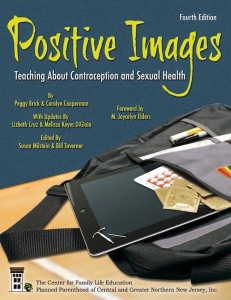This lesson is the one that gave the manual its title: Positive Images. When I first held this manual in my hands, I wasn’t quite sure what the title meant. The subtitle helped me out: Teaching about Contraception and Sexual Health. And then I could piece it together a little more: these lessons are all about public perception of and knowledge about contraception. That’s a good thing. But it is this lesson that really gets to the crux of the issue of the public image of contraception.
CREATING POSITIVE IMAGES
Advertising for Contraception and Safer Sex
Objectives
By the end of this lesson, participants will be able to:
- Explain the advantages of contraceptive use by creating advertisements for contraceptive devices and safer sex.
- Describe how advertising might influence the contraceptive and safer sex behavior of young people.
- Evaluate when it is important to use a condom in addition to another method.
- Describe the disadvantages that must be considered when choosing a particular method.
Rationale
Lower rates of teen pregnancy occur among countries that widely advertise birth control methods. Media is cited as a frequent source by young people for information about birth control. Experts suggest that media advertisements about contraceptives, safer sex, and emergency contraception could decrease the rates of teenage pregnancy and reduce the number of abortions. But there remains resistance among media sources to provide contraceptive and safer sex advertisements. In this lesson, participants will review information about contraceptives and safer sex in order to create much needed advertisements that are both appealing and accurate, and encourage condom use.
This lesson offers participants a chance to examine the methods that advertisements use to make products appealing and then apply those methods to contraception. As advertisements have become an increasingly popular source of medical information, it benefits young people to gain skills to create medical advertisements and then critically analyze that process of creation. The discussion questions that come after this activity are the meat of this process:
- Do any of the ads contain false claims for the product? How might false claims impact use of a contraceptive?
- There has been considerable debate about advertising contraceptives and safer sex. What are the pros and cons of having ads for condoms and other contraceptives in the media?
The remaining questions invite considered conversation about what it means to learn about contraception through advertisements, how advertisements are created and targeted, how to look for information underneath the promotion, and why these kinds of ads are generally more common in Europe than in the US.





